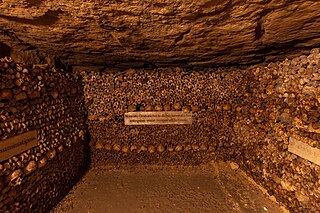
The Catacombs of Paris are underground ossuaries in Paris, France, which hold the remains of more than six million people. Built to consolidate Paris's ancient stone quarries, they extend south from the Barrière d'Enfer former city gate; the ossuary was created as part of the effort to eliminate the effects of the city's overflowing cemeteries. The consequences of the extreme amounts of rotting human flesh caused many people to fall ill, adding to the cemeteries even further. The Cemetery of Holy Innocence was, at one point, 8 feet above ground level due to the excess in bio-waste. Preparation work began shortly after a 1774 series of basement wall collapses around the Holy Innocents' Cemetery added a sense of urgency to the cemetery-eliminating measure, and from 1786, nightly processions of covered wagons transferred remains from most of Paris's cemeteries to a mine shaft opened near the Rue de la Tombe-Issoire.

Catacombs are human-made subterranean passageways for religious practice. Any chamber used as a burial place is considered a catacomb, although the word is most commonly associated with the Roman Empire.
Subterranean London refers to a number of subterranean structures that lie beneath London. The city has been occupied by humans for two millennia. Over time, the capital has acquired a vast number of these structures and spaces, often as a result of war and conflict.

The Catacombs of Rome are ancient catacombs, underground burial places in and around Rome, of which there are at least forty, some rediscovered only in recent decades.
An underground city is a series of linked subterranean spaces that may provide a defensive refuge; a place for living, working or shopping; a transit system; mausolea; wine or storage cellars; cisterns or drainage channels; or several of these. Underground cities may be currently active modern creations or they may be historic including ancient sites, some of which may be all or partially open to the public.

Highgate is a London Underground station and former railway station in Archway Road, in the London Borough of Haringey in north London. The station takes its name from nearby Highgate Village. It is on the High Barnet branch of the Northern line, between East Finchley and Archway stations, and is in Travelcard Zone 3.

A grotto is a natural or artificial cave used by humans in both modern times and antiquity, and historically or prehistorically. Naturally occurring grottoes are often small caves near water that are usually flooded or often flooded at high tide. Sometimes, artificial grottoes are used as garden features. The Grotta Azzurra at Capri and the grotto at Tiberius' Villa Jovis in the Bay of Naples are examples of popular natural seashore grottoes.
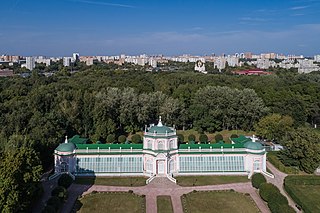
An orangery or orangerie is a room or dedicated building, historically where orange and other fruit trees are protected during the winter, as a large form of greenhouse or conservatory. In the modern day an orangery could refer to either a conservatory or greenhouse built to house fruit trees, or a conservatory or greenhouse meant for another purpose.

The Seattle Underground is a network of underground passageways and basements in the Pioneer Square neighborhood of Seattle, Washington, United States. They were located at ground level when the city was built in the mid-19th century but fell into disuse after the streets were elevated. In recent decades, they have become a tourist attraction, with guided tours taking place around the area.

Underground living refers to living below the ground's surface, whether in natural or manmade caves or structures. Underground dwellings are an alternative to above-ground dwellings for some home seekers, including those who are looking to minimize impact on the environment. Factories and office buildings can benefit from underground facilities for many of the same reasons as underground dwellings such as noise abatement, energy use, and security.

A utility vault is an underground room providing access to subterranean public utility equipment, such as valves for water or natural gas pipes, or switchgear for electrical or telecommunications equipment. A vault is often accessible directly from a street, sidewalk or other outdoor space, thereby distinct from a basement of a building.
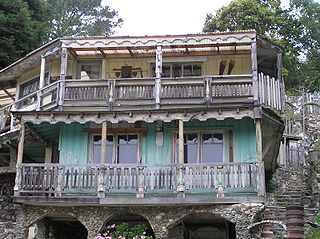
Nitt Witt Ridge is a house on two and a half acres in the coastal city of Cambria, California, United States. Artist and recluse Arthur "Art" Harold Beal (1896–1992) bought his hillside lot in 1928 and spent most of the next 50 years carving out the terraces with only a pick and shovel, creating his own "castle on a hill".
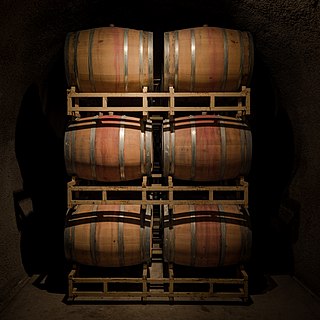
Wine caves are subterranean structures for the storage and the aging of wine. They are an integral component of the wine industry worldwide. The design and construction of wine caves represents a unique application of underground construction techniques.

The Odesa catacombs are a labyrinth-like network of tunnels located under the city of Odesa and its outskirts in Ukraine, that are mostly the result of stone mining, particularly coquina. The system of Odesa Catacombs consists of a network of basements, bunkers, drainage tunnels and storm drains as well as natural caves.
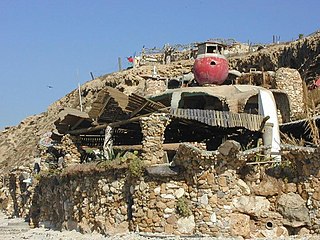
Hermit House is an earthen residence situated on a cliff overlooking the Mediterranean near the Sidna Ali Mosque in Herzliya, Israel, and is an example of vernacular architecture. Its owner, designer, and creator, Nissim Kahlon, has been building the structure solely by hand since the late 1970s, tunnelling deep into the cliff side and using natural sea materials.

Villa Torlonia is a villa and surrounding gardens in Rome, Italy, formerly belonging to the Torlonia family. It is entered from the via Nomentana.

The city of London, England, has several catacomb spaces, although the high water table limits subterranean construction. There has been a long tradition of burial under the floors of churches, and during the period of new church construction in the Victorian era many were provided with vaults or crypts under the main structure.
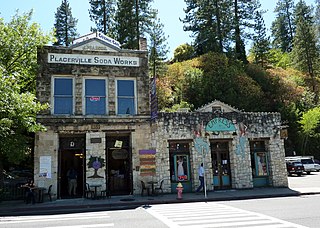
The John Pearson Soda Works, also referred to as the Placerville Soda Works, is a historic rustic vernacular Victorian brick building in Placerville, El Dorado County, California. The building, in the Gold Country region, was placed on the National Register of Historic Places (NRHP) on December 12, 1985. The building housed the Cozmic Café coffee shop and venue from 2003 until 2018.

Assmanshausen Winery is a heritage-listed former winery at Serisier Road, Toolburra, Southern Downs Region, Queensland, Australia. It was built from c. 1870 to c. 1881. It is also known as Toolburra Vineyards. It was added to the Queensland Heritage Register on 6 January 1999.

Hobby tunneling is tunnel construction as a pastime. Usually, hobby tunnelers dig their tunnels by hand, using little equipment, and some can spend years or even decades to achieve any degree of completion. In some cases tunnels have been dug secretly, and only discovered by chance.

























